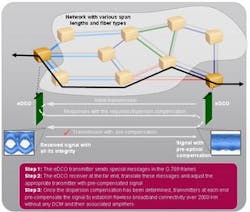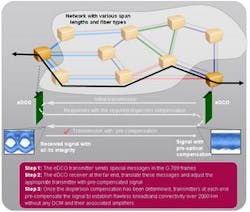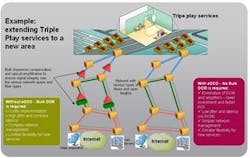Breaking physical barriers with electronic Dynamically Compensating Optics
Integrating eDCO features into the node eliminates the need for inline dispersion compensation equipment and enables multispan links of up to 2,000 km--all while maintaining the operational simplicity previously associated with 2.5-Gbit/sec networks.
By Fady Masoud
Nortel
New business and residential broadband services are driving service providers' implementation of emerging technologies--including passive optical networks (PONs), ultra-high-speed DSL, and Resilient Packet Ring (RPR)--and the use of multiple network topologies to meet subscribers' expectations for 'on demand' content any time, anywhere. However, many of these new services, including video-on-demand (VOD), voice-over-Internet-Protocol (VoIP), and content sharing, are difficult to forecast in terms of bandwidth demand and traffic routing patterns. They also have stringent quality-of-service (QoS) requirements. As a result, traffic patterns are more diverse and unpredictable, creating new operational challenges for service providers and cable operators who must forecast bandwidth requirements at the numerous sites spread across their networks.
Furthermore, the intense competition between various types of service providers dictates a higher level of flexibility, faster service turn-up, and--most importantly--new service economics. The network delivering these broadband services must be agile and adaptive to ever-changing business factors, including the expansion of served areas and the introduction of new services.
Today's network comprises a mix of new and old buildouts, where wavelengths travel across different distances and sometimes over different fiber types from source to destination. To accommodate diverse span lengths and fiber types, service providers must use bulk optical dispersion compensation to ensure maximum signal integrity, but this method significantly reduces network flexibility. Modifying or expanding the network becomes extremely complex, thus slowing down service providers' and cable operators' deployment of broadband and other emerging services.
Bulk dispersion compensation modules (DCMs) require the use of fixed dispersion maps. Service providers and cable operators must pre-plan the ultimate network length and topology, forecast where optical add/drop multiplexer (OADM) sites will occur, select DCM values individually for each span, and re-engineer after repairs or rerouting. A network with fixed dispersion maps can hardly evolve to support next-generation photonic switching capabilities like electronic reconfigurable optical add/drop multiplexers (eROADMs).
Furthermore, additional amplification is necessary to compensate for the link budget loss caused by bulk DCMs. This loss requires two line amplifier stages, resulting in increased real estate, power consumption, and capital expenditures. Such a configuration also increases network complexity and creates new failure points.
Electronic Dynamically Compensating Optics
Electronic Dynamically Compensating Optics (eDCO) technology solves the aforementioned issues related to bulk DCM while setting the network on an evolutionary path toward adaptive, all-optical, intelligent networking. eDCO pre-compensates each wavelength before its transmission, thus enabling service providers and cable operators to deploy systems in excess of 2,000 km while eliminating the need for inline dispersion slope compensation modules (DSCMs) and associated amplification requirements.
During initial system setup, a dispersion scan is invoked to determine the amount of dispersion to be applied by the transmitter. The eDCO encapsulate the aggregated traffic into standards-based G.709 OTU-2 frames, and special feedback messages are inserted in the overhead. At the other end, the eDCO receiver translates these messages and adjusts the appropriate transmitter. Once the dispersion scan is complete, optimization occurs to minimize pre-forward error correction (FEC) errors (See Figure 1).
Say a service provider is planning to extend its broadband and triple-play services into a new territory. The available fiber outlay providing connectivity to the new territory is a mix of various old and new fiber types (LEAF, LS-DSF, SMF-28, etc.) as depicted in Figure 2. To extend its broadband and triple-play services into the new territory, the service provider must address the following business and operational requirements:
• Ensure a minimum capital expenditure for faster return on investment (ROI);
• Maintain service integrity, as triple-play services like IPTV and VoIP have stringent quality requirements, including low jitter and latency;
• Avoid increasing network complexity;
• Future-proof the network for emerging services; and
• Ensure seamless network and service scalability.
Prior to the introduction of eDCO technology, the service provider had no other option but to implement bulk DCMs to provide wavelength connectivity to the remote territory, resulting in an extensive capital investment, significant increase in network complexity, and a reduction in network agility for future services.
Using eDCO, the service provider can extend its service to the new territory despite the mix of fiber types and without the need for DCMs and their associated amplifiers, thus reducing capital investment and accelerating ROI. Furthermore, the elimination of DCM removes a major source of jitter and latency.
eDCO interfaces dramatically reduce the transport cost of high-bandwidth signals, thanks to the technology's elimination of inline DSCMs and additional amplification. Other value-added benefits include:
• Enabling wavelength agility throughout the network without the need for pre-planned dispersion maps;
• Providing a day-one DWDM optical layer, which does not need to be engineered with a complex DSCM design;
• Reducing overall network latency due to the elimination of inline DSCMs;
• Extending the service reach (2000+ km) at a minimum cost while maintaining signal integrity (through enhanced FEC); and
• Increasing security against signal tapping due to pre-compensation (i.e., the prevention of video piracy).
eDCO perform dispersion compensation directly on the transmitter interfaces and provide real-time performance optimization on a per-wavelength basis while eliminating the need for pre-placement of DCMs in the optical DWDM line.
In addition to the aforementioned benefits, the implementation of eDCO translates into a significant reduction in capital and operational expenditures. The results of a real-life case study performed on a North American service provider's network revealed significant savings in both cost and time. For example, the amount of time required to add a new wavelength for VoD services, including validation procedures, power optimization, and network system line-up and test (SLAT), dropped 68%, from ten hours to just over four hours. Overall, eDCO resulted in combined operational savings (based on five-year net present value) of 56%.
In summary, eDCO breaks physical barriers to enable reliable and cost-effective broadband connectivity across 2,000-km spans and over any fiber buildout, while ensuring simple network management, flexibility, and scalability to meet the requirements of future growth.
Fady Masoud (PEng. M. Eng.) is a marketing manager in Nortel's Optical Networks Products and Solutions division. His area of expertise includes the definition, architecture, and requirements of next-generation optical platforms. Masoud holds a Bachelor's degree in Electrical Engineering from Laval University (Quebec City, Canada) and a Master's degree in Systems Technology (Simulation of Optical Networks) from the Superior School of Technology (Montreal, Canada.) He may be reached via [email protected].

